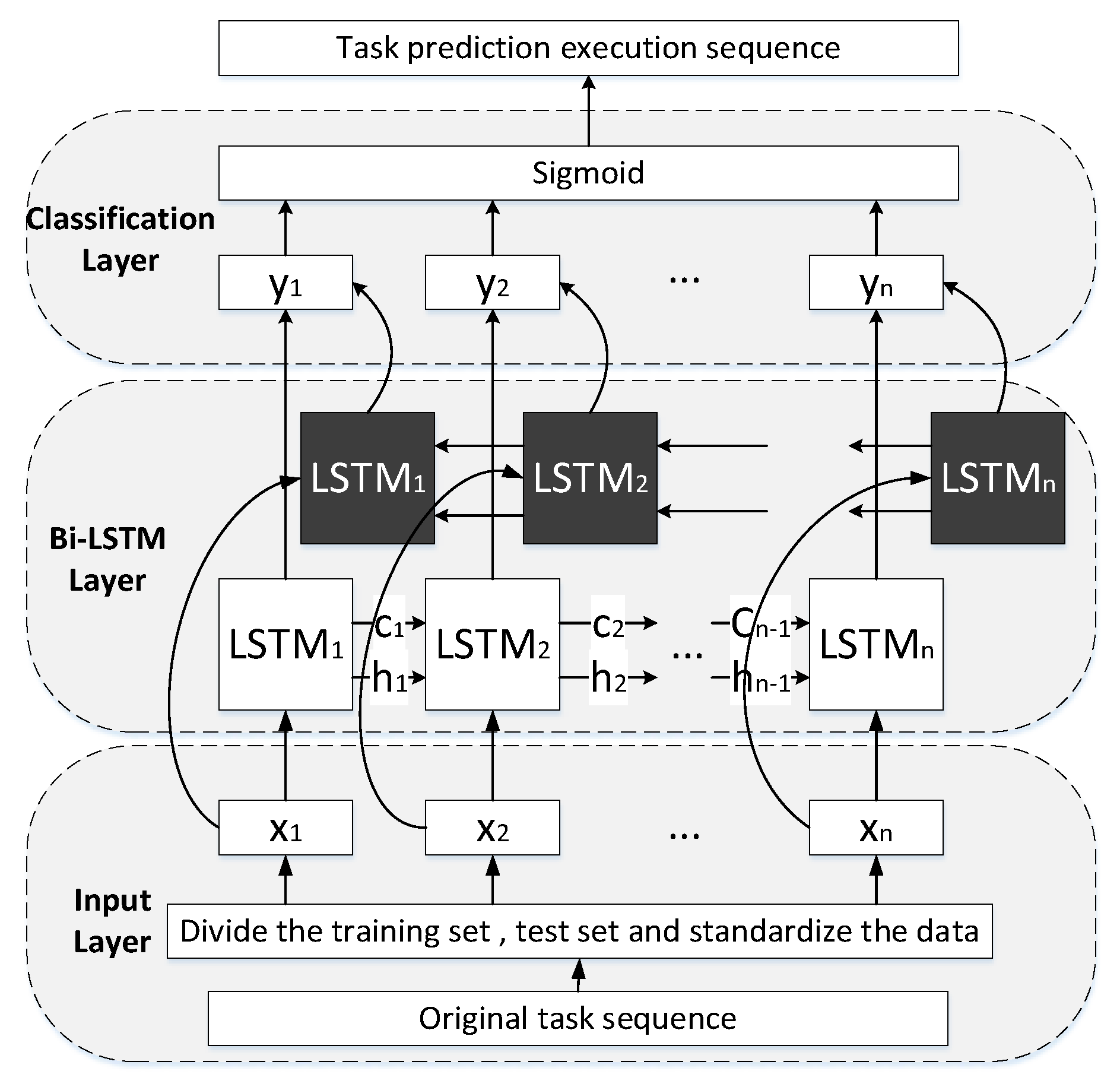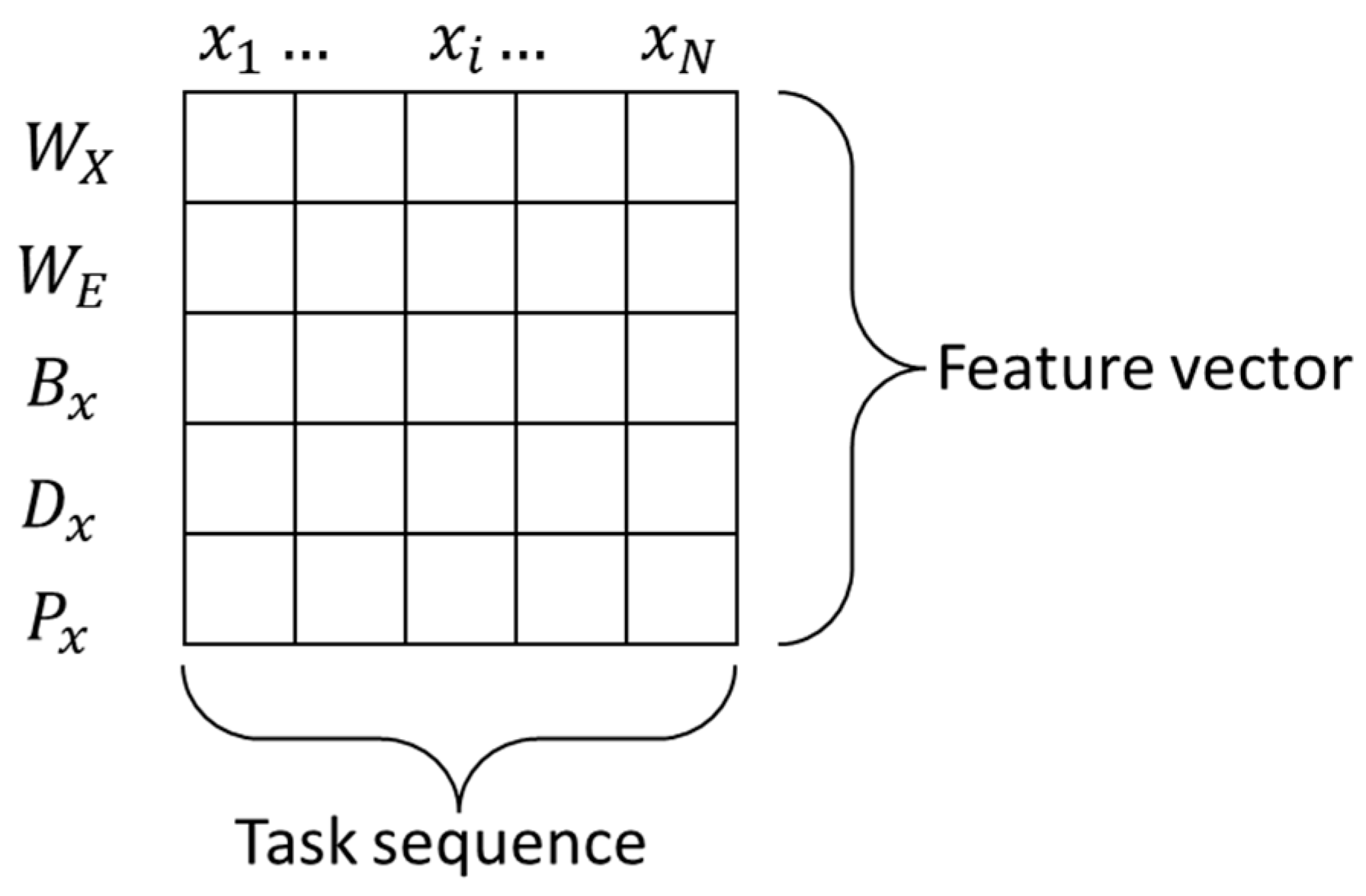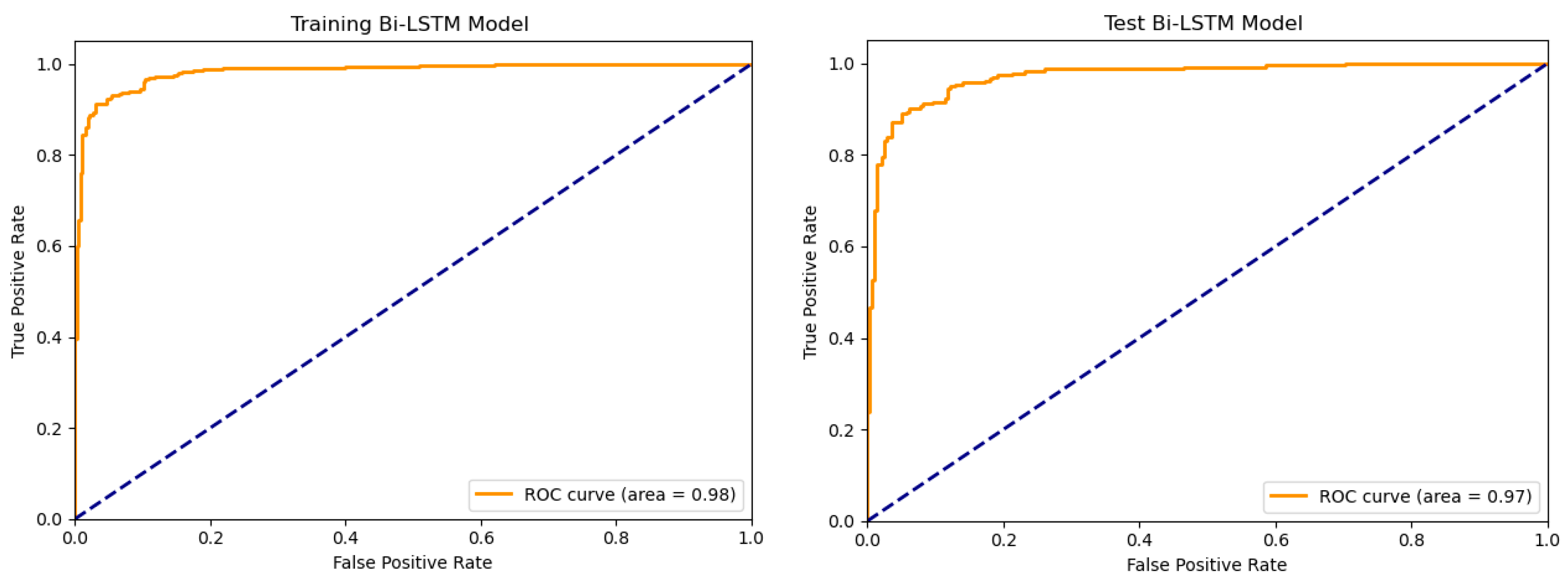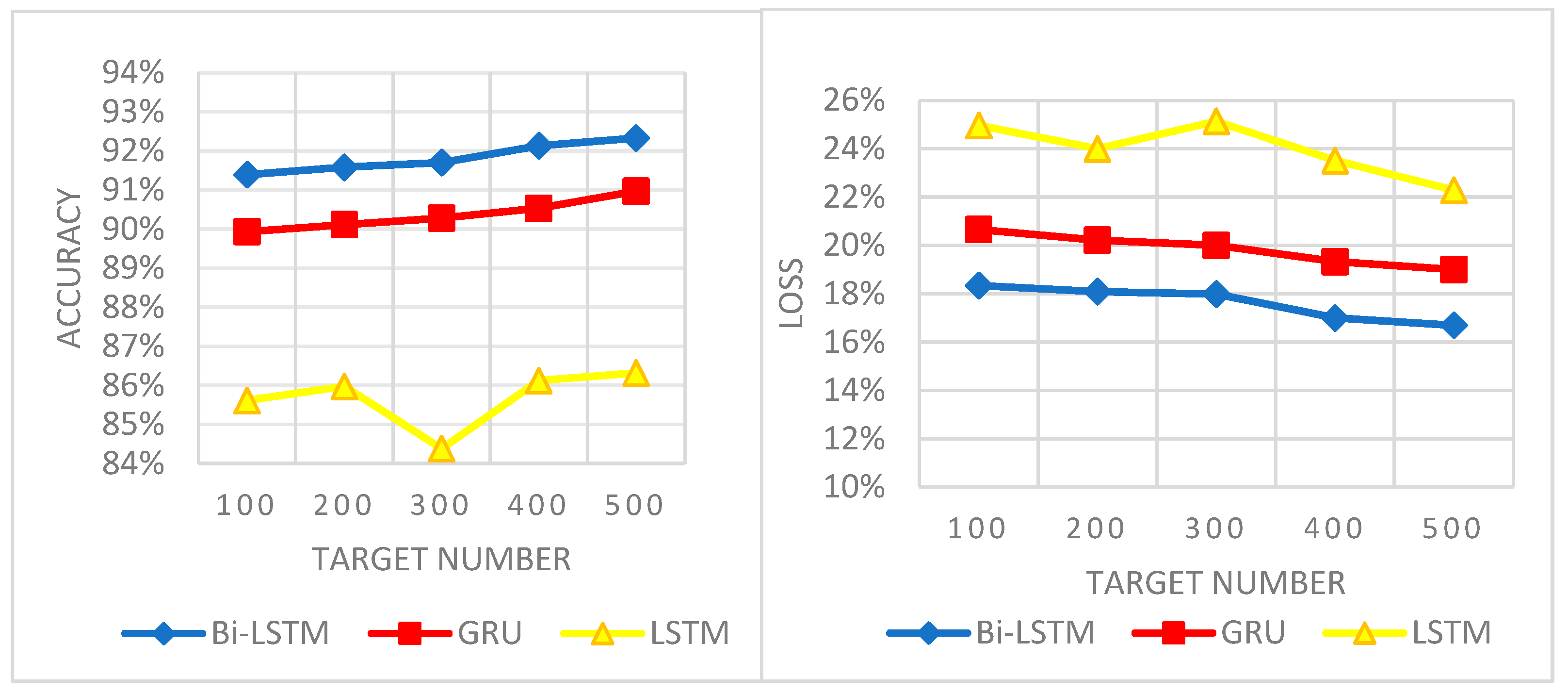Research on the Prediction Problem of Satellite Mission Schedulability Based on Bi-LSTM Model
Abstract
1. Introduction
2. Problem Description and Analysis
2.1. Input and Output of Task Scheduling Prediction Problem
2.2. Constraint Analysis
- Satellite Time Window Constraints
- 2.
- Power Constraint
- 3.
- Storage Constraints
2.3. Optimization Objective
3. Model Analysis
3.1. Introduction to Bi-LSTM
3.2. Model Construction
- Input Layer
- 2.
- Bi-LSTM layer
- 3.
- Classification Layer
3.3. Model Training
| Algorithm 1 Model training process pseudo-code |
| Input: Traindata/I Output: 1. Initialize i 2. 3. 4. 5. 6. for i = 1, …, I do 7. 8. 9. 10. 11. 12. 13. end if 14. end for |
4. Experiment and Analysis
4.1. Experimental Environment and Experimental Data
- Experimental hardware environment
- 2.
- Experimental data preparation
4.2. Model Parameter Settings
4.3. Evaluation Criteria and Model Results
5. Conclusions and Outlook
- To establish a multi-satellite task schedulable prediction model, use multi-satellite offline planning data for training, and realize the multi-satellite online task schedulable prediction function.
- To establish a satellite mission planning model on the basis of realizing the prediction function, further plan the prediction results, and realize the optimal planning of the mission under the condition of adding constraints such as the greatest benefit and the shortest planning time.
- When considering the constraints of satellite missions, this paper makes certain simplifications. In practical applications, all realistic constraints need to be considered to further improve the model.
Author Contributions
Funding
Conflicts of Interest
References
- Jun, J. Survey of remote sensing imaging observation technology. Northeast. Surv. Mapp. 2000, 23, 7–8. [Google Scholar]
- Bensana, E.; Verfaillie, G.; Agnese, J.C.; Bataille, N.; Blumstein, D. Exact and Inexact Methods for the Daily Management of an Earth Observation Satellite; European Space Agency: Paris, France, 1996. [Google Scholar]
- Tinker, P.; Fox, J.; Green, C.; Rome, D.; Casey, K.; Furmanski, C. Analogical and Case-Based Reasoning for Predicting Satellite Task Schedulability. In Proceedings of the International Conference on Case-based Reasoning Research & Development, Chicago, IL, USA, 23–26 August 2005; Springer: Berlin/Heidelberg, Germany, 2005. [Google Scholar]
- Li, J.; Jing, N.; Hu, W.; Chen, H. A satellite schedulability prediction algorithm for EO SPS. Chin. J. Aeronaut. 2013, 26, 705–716. [Google Scholar] [CrossRef]
- Bai, G.-Q.; Chen, Y.-W.; Yang, Z.-Y.; Liu, S. Prediction Method of Imaging Satellite Mission Schedulability Based on Integrated BP Neural Network; Chinese Academy of Astronautics; Institute of Electronics, Chinese Academy of Sciences: Beijing, China, 2013. [Google Scholar]
- Song, L.; Bai, G.-Q.; Chen, Y.-W. A method for predicting the schedulability of earth observation network imaging tasks. Chin. J. Astronaut. 2015, 36, 583–588. [Google Scholar]
- Xing, L.; Wang, Y.; He, Y.; He, L. Prediction method of onboard mission schedulability based on BP neural network. China Manag. Sci. 2015, S1, 117–124. [Google Scholar]
- Peng, S.; Chen, H.; Du, C.; Li, J.; Jing, N. Onboard Observation Task Planning for an Autonomous Earth Observation Satellite Using Long Short-Term Memory. IEEE Access 2018, 6, 65118–65129. [Google Scholar] [CrossRef]
- Hochreiter, S.; Schmidhuber, J. Long short-term memor. Neural Comput. 1997, 9, 1735–1780. [Google Scholar] [CrossRef] [PubMed]
- Gers, F.A.; Schmidhuber, J.; Cummins, F. Learning to Forget: Continual Prediction with LSTM; Istituto Dalle Molle Di Studi Sull Intelligenza Artificiale: Viganello, Switzerland, 1999. [Google Scholar]
- Bayer, J.; Wierstra, D.; Togelius, J.; Schmidhuber, J. Evolving memory cell structures for sequence learning. In Proceedings of the International Conference on Artificial Neural Networks, Limassol, Cyprus, 14–17 September 2009; Springer: Berlin/Heidelberg, Germany, 2009; pp. 755–764. [Google Scholar]
- Graves, A.; Fernández, S.; Schmidhuber, J. Bidirectional LSTM networks for improved phoneme classification and recognition. In Proceedings of the International Conference on Artificial Neural Networks, Warsaw, Poland, 11–15 September 2005; Springer: Berlin/Heidelberg, Germany, 2005; pp. 799–804. [Google Scholar]
- Zhang, Y.; Qu, L. Unipolar Sigmoid neural network classifier based on weights and structure determination method. J. Comput. Appl. 2013, 33, 766. [Google Scholar] [CrossRef]
- Schuster, M.; Paliwal, K.K. Bidirectional recurrent neural networks. IEEE Trans. Signal Process. 1997, 45, 2673–2681. [Google Scholar] [CrossRef]
- Martinez, M.; Stiefelhagen, R. Taming the cross entropy loss. In Proceedings of the German Conference on Pattern Recognition, Stuttgart, Germany, 9–12 October 2018; Springer: Cham, Switzerland, 2018; pp. 628–637. [Google Scholar]
- Kingma, D.P.; Ba, J. Adam: A method for stochastic optimization. arXiv 2014, arXiv:1412.6980. [Google Scholar]








Publisher’s Note: MDPI stays neutral with regard to jurisdictional claims in published maps and institutional affiliations. |
© 2022 by the authors. Licensee MDPI, Basel, Switzerland. This article is an open access article distributed under the terms and conditions of the Creative Commons Attribution (CC BY) license (https://creativecommons.org/licenses/by/4.0/).
Share and Cite
Zhang, G.; Li, X.; Wang, X.; Zhang, Z.; Hu, G.; Li, Y.; Zhang, R. Research on the Prediction Problem of Satellite Mission Schedulability Based on Bi-LSTM Model. Aerospace 2022, 9, 676. https://doi.org/10.3390/aerospace9110676
Zhang G, Li X, Wang X, Zhang Z, Hu G, Li Y, Zhang R. Research on the Prediction Problem of Satellite Mission Schedulability Based on Bi-LSTM Model. Aerospace. 2022; 9(11):676. https://doi.org/10.3390/aerospace9110676
Chicago/Turabian StyleZhang, Guohui, Xinhong Li, Xun Wang, Zhibing Zhang, Gangxuan Hu, Yanyan Li, and Rui Zhang. 2022. "Research on the Prediction Problem of Satellite Mission Schedulability Based on Bi-LSTM Model" Aerospace 9, no. 11: 676. https://doi.org/10.3390/aerospace9110676
APA StyleZhang, G., Li, X., Wang, X., Zhang, Z., Hu, G., Li, Y., & Zhang, R. (2022). Research on the Prediction Problem of Satellite Mission Schedulability Based on Bi-LSTM Model. Aerospace, 9(11), 676. https://doi.org/10.3390/aerospace9110676





